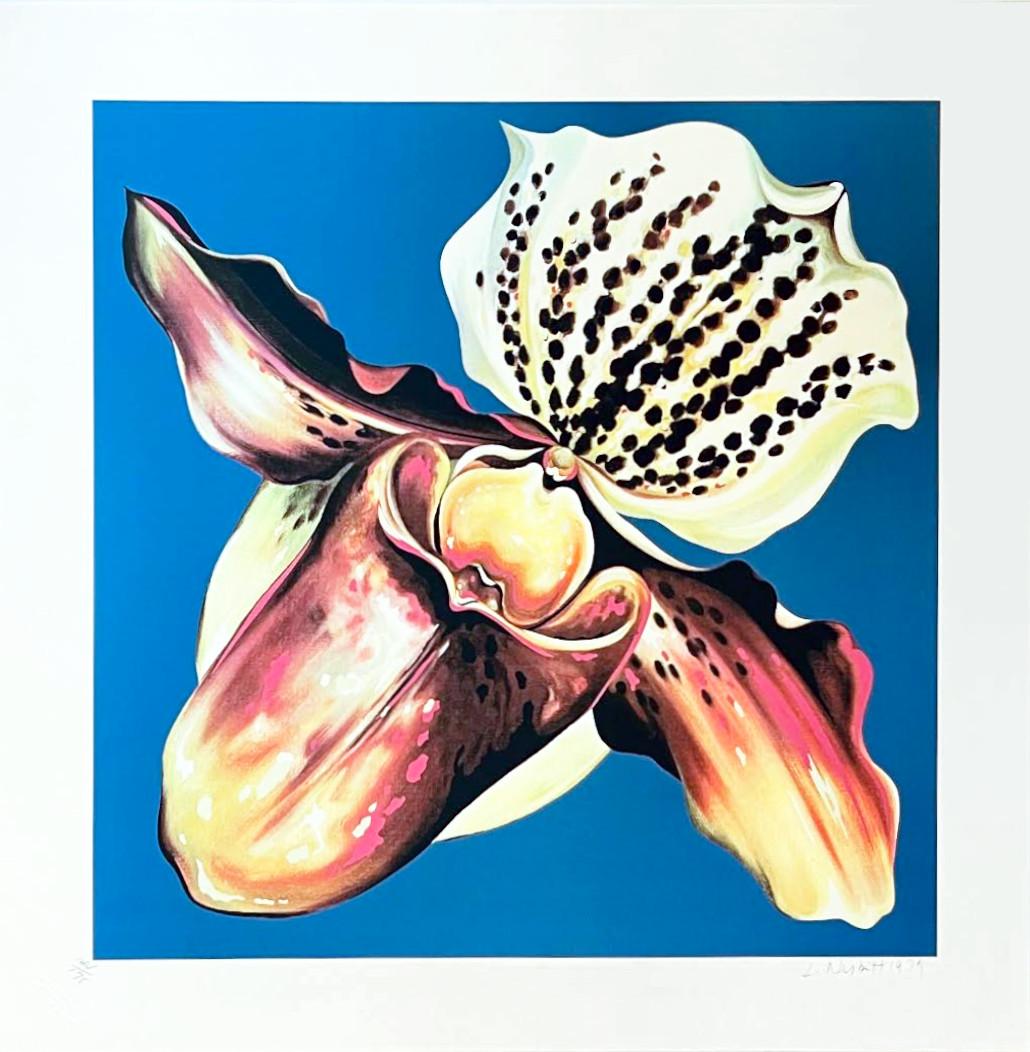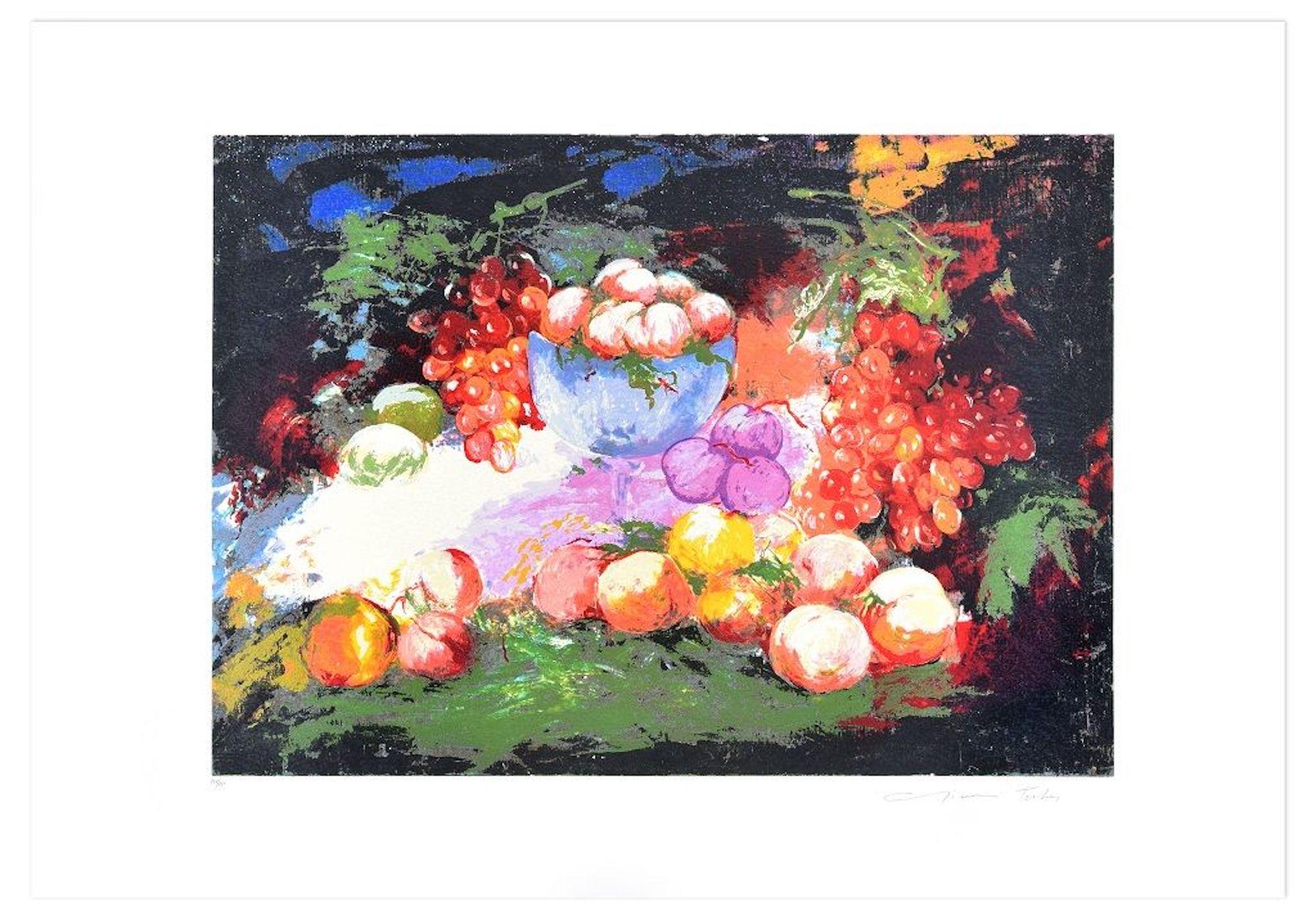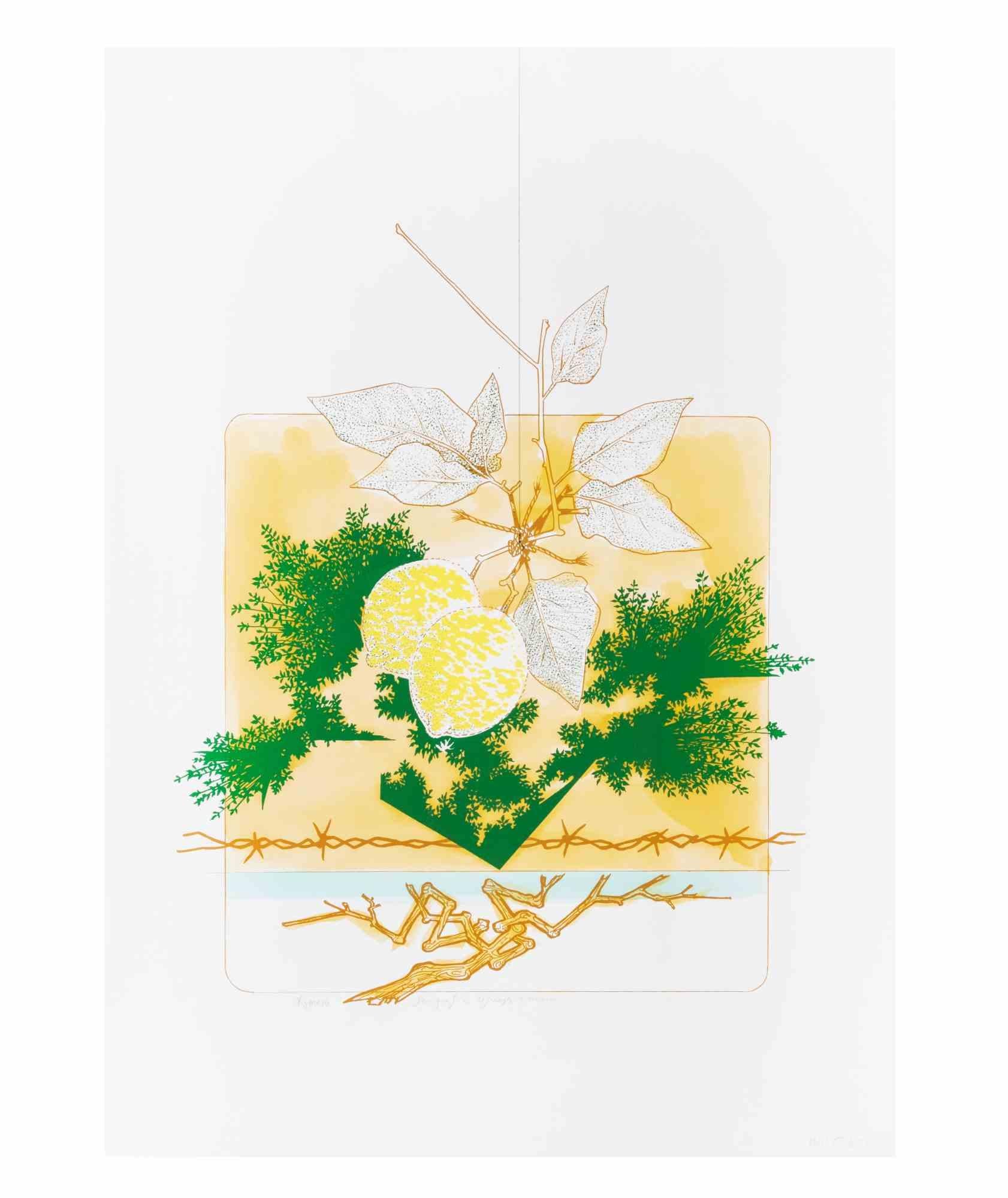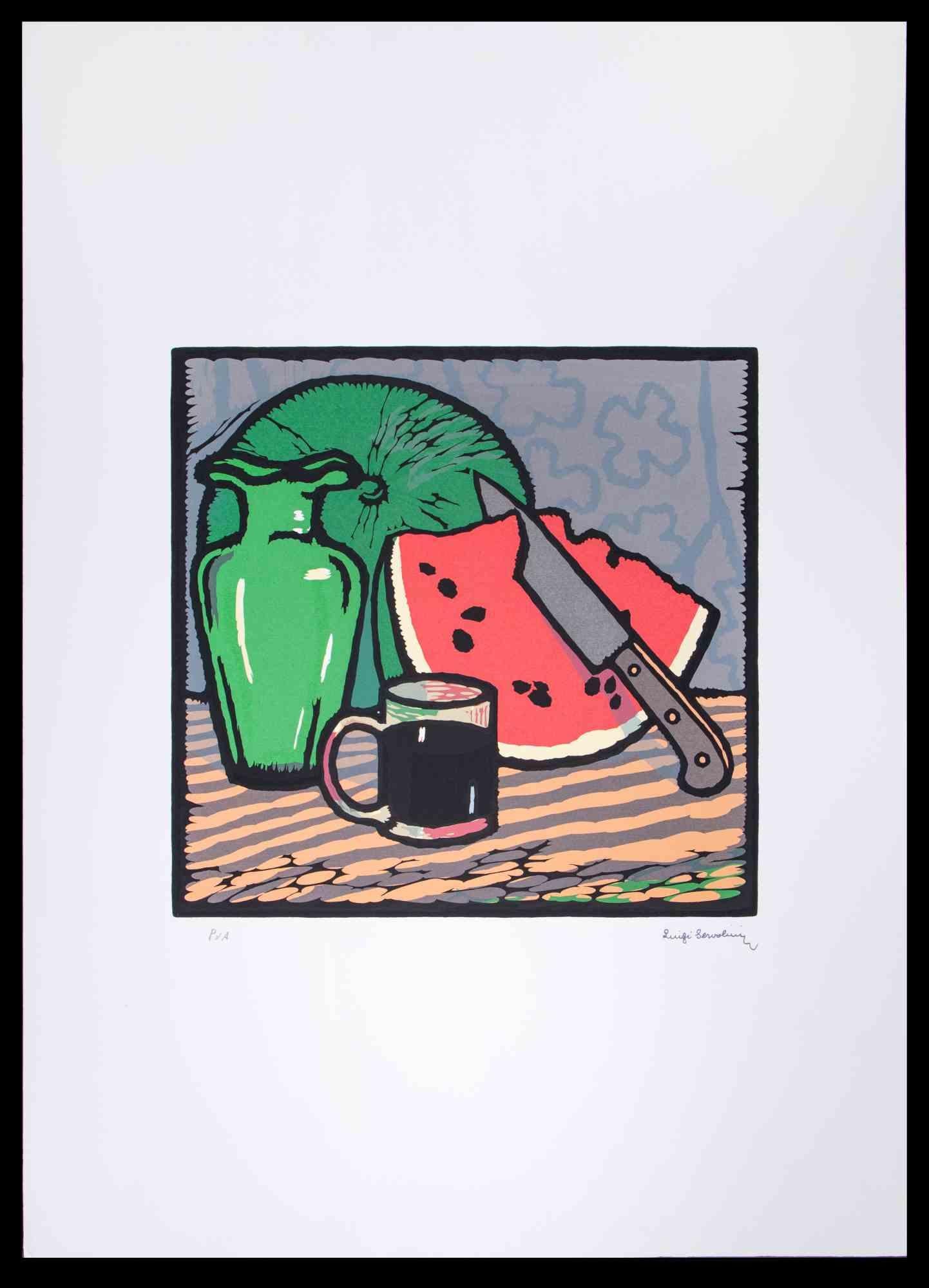Jonas WoodBromeliad2020
2020
About the Item
- Creator:Jonas Wood (1977, American)
- Creation Year:2020
- Dimensions:Height: 28 in (71.12 cm)Width: 23 in (58.42 cm)
- Medium:
- Movement & Style:
- Period:
- Condition:
- Gallery Location:New York, NY
- Reference Number:1stDibs: LU1745214134252
Jonas Wood
In his boldly colored, graphic works — including paintings, drawings, and prints — Jonas Wood combines art historical references with images of the objects, interiors, and people that comprise the fabric of his life. Translating the three-dimensional world around him into flat color and line, he confounds expectations of scale and vantage point.
"You could call [my work] a visual diary or even a personal history," Wood says. "I’m not going to paint something that doesn’t have anything to do with me. Of all of the possible things I could paint, the thing that interests me is something that I can get close enough to in order to paint it honestly."
Born in Boston, Wood grew up surrounded by the art collection of his grandfather, featuring the work of artists such as Francis Bacon, Alexander Calder, Jim Dine, Robert Motherwell, Larry Rivers, and Andy Warhol. He received a BA from Hobart and William Smith Colleges, Geneva, New York, in 1999, majoring in psychology and minoring in studio art, then attended the University of Washington, Seattle, where he received an MFA in painting and drawing in 2002. During his student years, he explored making collage-like works based on montaged photographs that he took of himself, his friends, and their surroundings. These early photo-based paintings possess a darker and more volatile energy that is not as immediately evident in the work Wood is known for today.
Shortly after art school, Wood moved to Los Angeles, where he worked for the painter Laura Owens for a few years. Wood currently shares a studio with artist Shio Kusaka, his wife since 2002, and the pair often work in tandem, motifs migrating from Kusaka’s ceramic vessels to Wood’s paintings and back again. Common subjects include plants, portraits, and sports imagery, all of which come together in Wood’s lush interiors and intricate still lifes. He and Kusaka also incorporate imagery from their expansive art collection — including works by Alighiero Boetti, Michael Frimkess and Magdalena Suarez Frimkess, Mark Grotjahn, and Ed Ruscha — as well as from their children’s storybooks and drawings.
In 2010, Wood had his first solo museum exhibition, at the Hammer Museum in Los Angeles. The exhibition was followed by a number of public commissions, including murals for the High Line, New York (Shelf Still Life, 2014) and the façades of LAXART, Los Angeles (2014) and the Museum of Contemporary Art, Los Angeles (Still Life with Two Owls, 2016).
Wood often works in categories of distinct subject matter, and the publications that are made alongside his exhibitions, or in retrospect, highlight his interest in these genres. "Interiors" (2012) gathers works showing various domestic spaces; "Pots" (2015), paintings of flattened vessels featuring imagery from pop culture and art history; "Portraits" (2016), group and single portraits of Wood’s family, friends, and sports heroes; and "Clippings" (2017), depictions of overlapping stems, leaves, and flowers.
Find original Jonas Wood art on 1stDibs.
- ShippingRetrieving quote...Ships From: New York, NY
- Return PolicyA return for this item may be initiated within 1 day of delivery.
- Orchid, gorgeous signed/n silkscreen by renowned 1970s realist artistBy Lowell NesbittLocated in New York, NYLowell Nesbitt Orchid, 1979 Silkscreen on wove paper Pencil signed, dated and numbered 144/175 by Lowell Nesbitt on the front Published by Charles Cardinale Fine Creations, Inc., with blind stamp on the front 25 × 25 inches Unframed This work is pencil signed, dated and numbered 144/175 by Lowell Nesbitt on the front. About Lowell Nesbitt. Lowell Nesbitt, who was born in Baltimore on Oct. 4, 1933, was a graduate of the Tyler School of Art at Temple University in Philadelphia and also attended the Royal College of Art in London, where he worked in stained glass & etching. In 1964, the Corcoran Gallery or Art in Washington gave him one of his first museum exhibitions, and by the mid 1970's he had decided to leave the museum a bequest of more than $1 million. But in 1989, he publicly revoked the bequest after the Corcoran canceled a disputed exhibition of photographs by Robert Mapplethorpe, who was an old friend. Mr. Nesbitt named the Phillips Collection as a beneficiary instead. He was frequently grouped with the Photo Realists, but his images were more interpretively distorted, somewhat loosely painted and boldly abbreviated. He had many subjects: studio interiors, articles of clothing, piles of shoes and groupings of fruits and vegetables. He also painted his dog, a Rottweiler named Echo, the Neoclassical facades of SoHo's 19th century cast-iron buildings and several of Manhattan's major bridges. Despite such variety, Lowell Nesbitt was best known for gargantuan images or irises, roses, lilies and other flowers, which he often depicted in close up so that their petals seemed to fill the canvas. Dramatic, implicitly sexual and a little ominous, they earned the artist a popularity with the general public that tended to overshadow his reputation within the art world. In 1980, the United States Postal Service issued four stamps based on Mr. Nesbitt's floral paintings. He also served as the official artist for the space flights of Apollo 9...Category
1970s Realist Figurative Prints
MaterialsScreen, Pencil, Graphite
- Untitled, from the Art Against AIDS PortfolioLocated in New York, NYGael Stack Untitled, from the Art Against AIDS Portfolio, 1988 Woodcut on paper with deckled edges. Hand signed. Numbered. Printer's and Publisher's Blindstamp. Unframed. Hand signed and numbered on the lower recto (front) with printer's and publisher's blindstamp. Edition 38/50 20 × 15 inches Publisher Little Egypt Enterprises, Houston, TX Provenance Art Against AIDS Portfolio, numbered 38/50 This beautiful limited edition woodcut by Gael Stack was published in 1988 as part of the Art Against Aids portfolio, numbered 38/50. Superb provenance as it is was acquired from the original Art Against AIDS Portfolio published in Houston, Texas. This will be the first time the work will be removed from the portfolio. The late 1980s was the height of the AIDS epidemic, and this was one of many efforts by the creative community to raise funds to assist in fighting this deadly scourge that disproportionately affected the artistic community. Measurements: 20 x 15 inches (sheet) 8 1/4 x 12 inches(image) The complete Art Against AIDS Portfolio is comprised of 10 prints, in black and white and color, from 10 artists. About Gael Stack: Gael Stack is a Texas painter. She lives in Houston and has work in the permanent collections of several museums. Stack has worked as a professor at the University of Houston...Category
1980s Contemporary Figurative Prints
MaterialsPencil, Woodcut
- Place Setting (bread basket, glasses, butter dish) signed/n, top realist painterBy John MooreLocated in New York, NYJohn Moore (b.1941) Place Setting, 1979 Lithograph on wove paper Hand signed, dated, titled and numbered 29/100 by John Moore on the bottom front 17 × 22 inches Unframed This elegant still life lithograph is hand signed, dated, titled and numbered 29/100 by John Moore on the bottom front. About John Moore: John Moore is an acclaimed contemporary realist painter...Category
1970s Realist Still-life Prints
MaterialsPencil, Lithograph
- Red RoseBy Lowell NesbittLocated in New York, NYLowell Nesbitt Red Rose, 1985 Silkscreen on wove paper Signed, dated, and numbered AP 9/25 by Lowell Nesbitt on the front 24 × 24 inches Unframed Hand signed,...Category
1980s Realist Figurative Prints
MaterialsScreen
- SummerBy Paula ScherLocated in New York, NYPaula Scher Summer, ca. 1987 Silkscreen in Colors on Rives BFK Paper. 36 × 29 3/5 inches Edition 81/190 Signed in graphite lower right margin front; numbered in graphite lower left m...Category
1980s Pop Art Figurative Prints
MaterialsScreen
- ToxicologyBy Kiki SmithLocated in New York, NYKiki Smith Toxicology, 2009 Linotype and engraving in black, gray, and yellow on white wove paper. Printed from a magnesium engraving on Vandercook cylinder presses. Hand signed by ...Category
Early 2000s Contemporary Figurative Prints
MaterialsEtching, Linocut
- Still Life - Original Screen Print by Gianni Testa - 1980sBy Gianni TestaLocated in Roma, ITStill Life is an original print realized by the Italian artist Gianni Testa (1936) in 1986. Original mixed colored serigraph. Hand-signed by the artist on lower right. Numbered on...Category
1980s Contemporary Figurative Prints
MaterialsScreen
- Lemons - Screen Print by Leo Guida - 1972By Leo GuidaLocated in Roma, ITLemons is a screen print realized by Leo Guida in 1972s. Good condition, no signature, titled with pencil. Artist sensitive to current issues, artistic movements and historical tec...Category
1970s Contemporary Figurative Prints
MaterialsScreen
- Still Life - Screen Print by Leo Guida - 1976By Leo GuidaLocated in Roma, ITStill Life is an artwork realized in 1976 by the Italian Contemporary artist Leo Guida (1992 - 2017). Original screen print on cardboard Hand-signed on the lower right in pencil ...Category
1970s Contemporary Still-life Prints
MaterialsScreen
- Still Life - Original Screen Print by Luigi Servolini - 1950sBy Luigi ServoliniLocated in Roma, ITStill Life is an original contemporary artwork realized in the 1950s by the Italian artist Luigi Servolini (Livorno, 1906 – Livorno, 1981). Original screen print. Signed on the lower right corner and numbered in the opposite corner 2/125. Good condition. Artist proof. Luigi Servolini (Livorno, 1906 – Livorno, 1981). He graduated in Literature at the University of Pisa, then he graduated at the Academy of Fine Arts in Carrara, then he specialized in History of Medieval and Modern Art at the University of Florence. Since that time he has held various roles within the Italian academic world. In 1935 he promoted the creation of a Museum of Xylography in Carpi, the birthplace of the master Ugo da Carpi...Category
1950s Contemporary Figurative Prints
MaterialsScreen
- Still Life - Original Screen Print by Luigi Servolini - 1950sBy Luigi ServoliniLocated in Roma, ITStill Life is an original contemporary artwork realized in the 1950s by the Italian artist Luigi Servolini (Livorno, 1906 – Livorno, 1981). Original screen print. Signed on the lower right corner and numbered in the opposite corner 7/125. Good condition. Luigi Servolini (Livorno, 1906 – Livorno, 1981). He g raduated in Literature at the University of Pisa, then he graduated at the Academy of Fine Arts in Carrara, then he specialized in History of Medieval and Modern Art at the University of Florence. Since that time he has held various roles within the Italian academic world. In 1935 he promoted the creation of a Museum of Xylography in Carpi, the birthplace of the master Ugo da Carpi...Category
1950s Contemporary Figurative Prints
MaterialsScreen
- Wes Lang, Thoughts For The Free Life #15 - Signed Print, Contemporary ArtBy Wes LangLocated in Hamburg, DEWes Lang (American, b. 1972) Thoughts For The Free Life #15, 2023 Medium: Screen print on Somerset 280/gsm paper Dimensions: 58.4 × 91.4 cm (23 x 36 in) Edition of 100 + 15 AP: Hand-...Category
21st Century and Contemporary Contemporary Figurative Prints
MaterialsScreen






